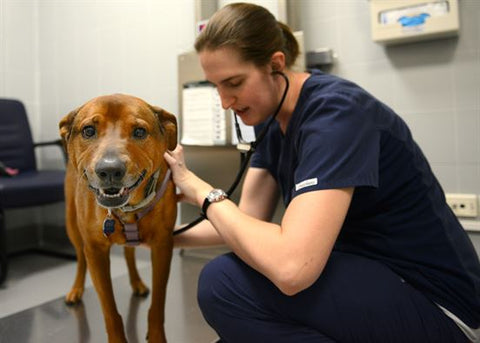Pet First Aid Tips

Most of us don’t think about how we should handle a pet medical emergency until something happens to one of our beloved pets. Get ahead of the curve by learning the basics of pet first aid and having the necessities on hand.
It could save your pet’s life!
The Basics
First, know where to take your pet in the event of a medical emergency. Whether you’re at home, on the road, camping, or on vacation, you may not have the internet access needed to search for an emergency animal hospital’s phone number or address.
Another important number to have on hand is the Animal Poison Control Center: 888-426-4435. They charge a fee for their assistance, but if you believe your pet has ingested something poisonous, their help could make the difference in your pet’s life.
If your pet is injured, it will be afraid and in pain -- you will need to gently muzzle or restrain your pet, being careful to keep your face a safe distance away.
Depending on the issue, you will want to restrain your cat by wrapping it in a towel or blanket, or by putting it in a carrier. Muzzle your dog only if it is not vomiting. You can use a soft cloth, gauze roll, or tie if you don’t have a muzzle.
Do not handle your pet more than necessary if it is agitated or in pain.
What to Have on Hand
- Leash or carrier
- Muzzle (a gauze roll, soft cloth, or tie will also work)
- Clean towels or pieces of cloth
- Gauze rolls
- Medical Tape
- Digital ‘fever’ thermometer (rectal)
- Eye dropper (for oral medication and cleaning wounds)
- Saline Solution (for cleaning wounds)
- Hydrogen Peroxide 3% (induces vomiting)
- Milk of Magnesia or Activated Charcoal (absorbs poison)
- Blanket, rug, or plank of wood (to move an injured animal)
What You Can Do
There is a great deal that YOU can do to treat and stabilize your pet before taking it to the vet for an examination and treatment. For example, if your pet is injured, you may need to stabilize it before transfer.
Carefully splinting a broken bone or bandaging a wound will help ease your pet’s discomfort during transport. If your pet has a wound that is bleeding, you will need to get the bleeding under control immediately. Use a clean cloth to apply direct pressure for 3 minutes.
If the bleeding continues, transfer your pet to a veterinarian as quickly as possible, and add more layers of cloth on top without removing the base layer.
For some medical emergencies, you should take your pet to your vet or emergency animal clinic immediately, without applying first aid.
For detailed instructions on what to do in each circumstance, take a look this pamphlet by the American Veterinary Medical Association. It covers heat stroke, poisoning, seizures, choking, and much more.
Signs to Watch out for
- Poisoning: Internal/external bleeding, dilated pupils, drooling or foaming mouth, lethargy, seizures
- Dehydration: Pull up the skin between to shoulder blades -- if it doesn’t bounce back, this is a sign of dehydration
- Heat Stroke: Body temperature above 104 Fahrenheit, excessive panting, difficulty breathing, wobbliness, collapsing, bloody diarrhea, vomiting, red mucous membranes, increased salivation, increased heart rate
- Choking: Difficulty breathing, making choking noises when breathing or coughing, pawing at the mouth, blue lips or tongue
By learning basic pet first aid and having the above necessities on hand, you’ll be better equipped to help your pet survive a medical emergency.
This article covers only the very basics of pet first aid. For more in-depth information or training, try taking a pet first aid class online or at your local humane society.
Remember to always contact your veterinarian or animal emergency clinic immediately if any of the medical emergencies covered in this article happen to your pet.



